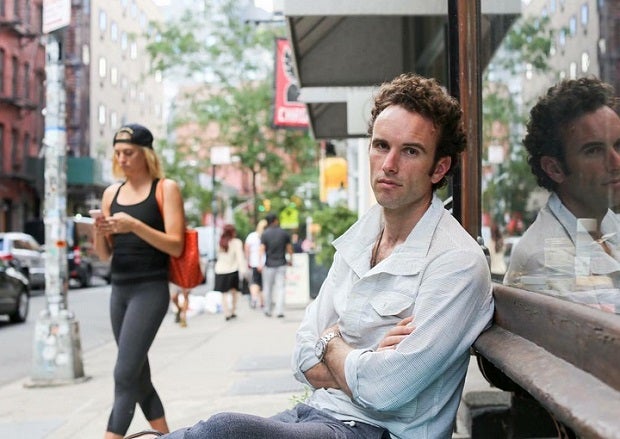Humans Of New York Photos Cast A Light On The TRUE Faces Of PTSD
Caring for our veterans means caring for their mental health too.
 Instagram/@humansofny
Instagram/@humansofny American war veterans sacrifice so much, but too often, as a community, we fail to take care of their needs, both in terms of their physical and mental health, when they return from combat.
Brandon Stanton’s Humans of New York and the Headstrong Project are trying to start a dialogue about the experiences of veterans with their breathtaking new “Invisible Wounds” series — a collection of images and first-hand accounts of Iraq and Afghanistan veterans opening up about their time overseas and their personal struggles with conditions like post-traumatic stress disorder.
But that’s not to suggest that all of these veterans have PTSD. To quote Stanton, “Many of these stories will include PTSD, but the hardships of returning veterans are far too nuanced for a single diagnosis. And it can be inappropriate to use PTSD as a catch-all for those hardships.”
It’s why they named the series “Invisible Wounds,” because the stories of these veterans are so complex, nuanced, and individual that they can’t easily be categorized. Some of the veterans in the series are definitely suffering from PTSD, but others are grappling with things harder to define.
HONY and the Headstrong Project are more interested in simply sharing their stories, showing the humanity behind the horrific experiences, in the hopes of raising awareness of their hardships and letting other veterans know that they’re not alone.
That’s important because there is, unquestionably, a mental health crisis affecting American war veterans right now.
The Headstrong Project, an organization that provides veterans of Iraq and Afghanistan with “free mental health care that works,” estimates that “for every soldier we have lost in combat, 25-30 take their own lives.”
That’s an absolutely chilling statistic, one that underlines the importance of efforts like “Invisible Wounds” — anything to let veterans know that they’re not alone and there are people in the world who want to hear their stories.
Below, you’ll see some photographs and excerpts from a few of the brave souls featured in the series so far. If you’re anything like me, you will be amazed at how familiar and honest their faces look, even as you hold your breath while reading their moving stories about the horrors of life during (and after) wartime.
If you want to see the complete series, you can check out the Humans of New York Instagram page. And if you want more information on the Headstrong Project, you can find it here.
1.“It’s the most embarrassing thing a grown man can experience.”
 Instagram/@humansofny
Instagram/@humansofny
“It’s the most embarrassing thing a grown man can experience. It’s like having a nightmare while awake. … I had to get help. I lost a whole line of mentors to suicide and I didn’t want it to be me too. Maybe some guys can come home from war and go back to mowing their lawn or fixing their gutters — good on them. But I had to get help.” (Source)
2.“Then at one point I decided that I was going to try everything possible to feel better.”
 Instagram/@humansofny
Instagram/@humansofny
“For a long time after I got back, I isolated myself in a cabin and drank all the time. Then at one point I decided that I was going to try everything possible to feel better. … Recently I’ve been experimenting with femininity. … I was always the tough chick. Now I’m trying to go in the opposite direction. I'm being very cliche about it. I’m doing yoga. I’m wearing dresses everyday. I’m wearing make-up. I even joined a woman’s group. Every month we have a sacred circle on the new moon and do guided meditations, set intentions, and eat chocolate. God, this is harder to talk about than bombs.” (Source)
3.“It’s hard to come back.”
 Instagram/@humansofny
Instagram/@humansofny
“You see this really fucking horrible stuff. You see guys blown to bits. You see dogs eating people. And the whole time there’s this little voice in your head that says: ‘That’s not normal, that’s not normal.’ And the longer you stay in that place, the quieter the voice gets. That voice is like your anchor. If it gets too quiet, it’s hard to come back.” (Source)
4.“I remember walking into my therapist’s office and saying: ‘This stuff actually works!’”
 Instagram/@humansofny
Instagram/@humansofny
“I went through a treatment called EMDR. My therapist would take me back to every point of trauma and have me describe it in detail. It was like literally going back in time. I could touch the faces of all the guys I’d lost. I could talk to them. We could talk about what happened. And how we all knew the risks. And how sometimes people died. And it was nobody’s fault. And I could apologize to them. And when it was over I’d be completely exhausted. And I’d feel like a bitch because I’d just cried for an hour. But it worked. The symptoms started to go away. After a few sessions, I remember walking into my therapist’s office and saying: ‘This stuff actually works!’ And he said: ‘Yeah. It does.’” (Source)
5.“I’d never gotten help because I never wanted to appear weak.”
 Instagram/@humansofny
Instagram/@humansofny
“I’d never gotten help because I never wanted to appear weak. I’m the son of a man who lost his entire team in Vietnam. I’ve been through some of the toughest training on earth. I never quit anything in my life. So it took me the longest time to admit that I had a problem. … But it finally caught up with me. And I broke down. And those two guys convinced me to go to therapy. And it was the best decision I’ve ever made. I used to think that I was weak for needing help. I realize now that my weakness was never getting it.” (Source)

